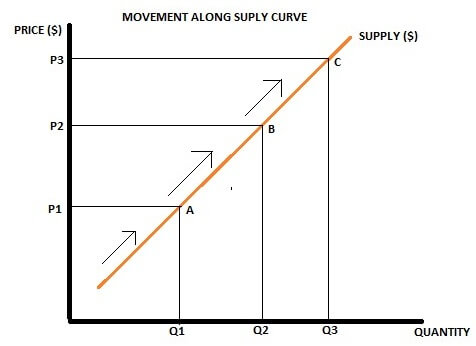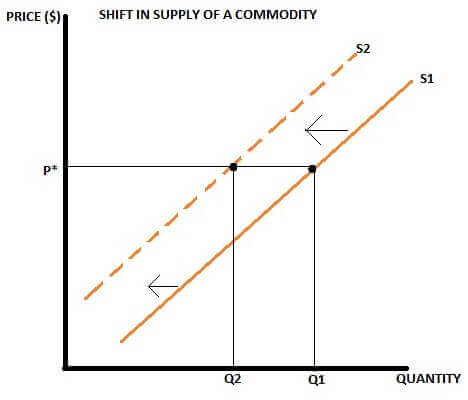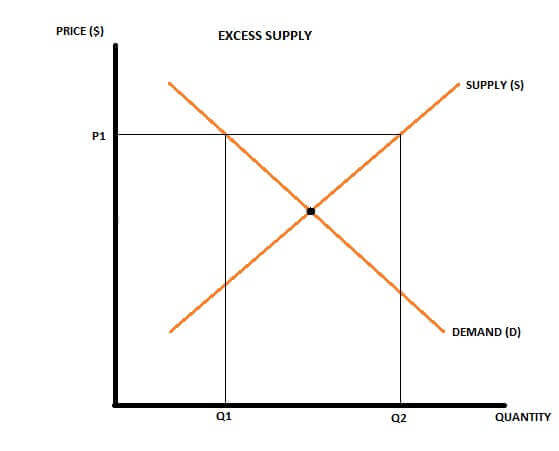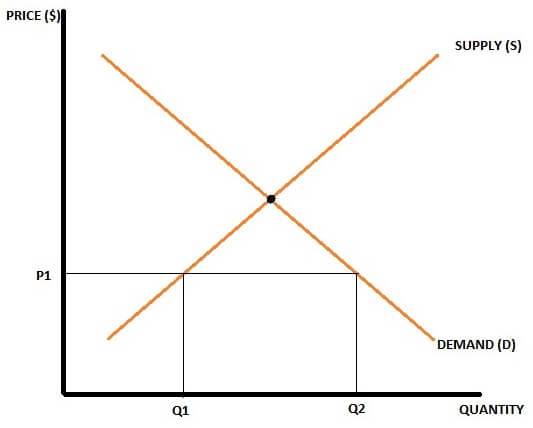Supply and Demand
SUPPLY AND DEMAND ANALYSIS
In economics market is a wonderful tool operated by an invisible hand in a competitive world. It involves different buyers, sellers and other economic actors who come together at one place and trade in a given good or a service by reinforcing efficient allocation of resources. Supply & demand of goods or services is what the economics all about. This concept of supply and demand is the basic concept which lays the foundations of whole story in economics. Supply and demand is an economic model of price determination in a market economy.
SUPPLY refers to the total amount of a specific good (or a product) available in the market place at a given point of time. This is how much the economy can offer to buyers of the good.
DEMAND refers to the total amount (quantity) of a good that buyers (or consumers) desire in an economy. Quantity demanded of a product is the amount of that product people are willing and able to buy at a specified price.
The terms supply and demand are usually studied in economics as a relationship between price and quantity of the concerned good. Demand relation specifies the relation between the price and quantity demanded by the buyers in the economy while supply relation specifies the relation between the price and quantity supplied by producers or the intermediaries.
In any market, it is assumed that the demand & supply mechanism will allocate the resources in the most efficient way possible. Let’s dig a little bit more into the wonders of supply and demand and the law governing these concepts.
Law of Demand
The law of demand states that keeping other factors constant (ceteris paribus), when the price of a good falls, the quantity demanded by the buyers for that good rises. Similarly, as the prices of the good rises, the quantity demanded for the good falls. The reason behind this law is a whole new story.
When the price of the good 1 increases, the opportunity cost for the consumer also increases as to buy the same good the consumer has to shell out more money. Since resources are limited while wants are unlimited, the consumer will have to forgo the consumption of the commodity (say good 2) he prefers more in order to buy good 1. This is what a rational consumer would not do.
The relation between demand and price of a commodity can be explained through the following graph:

The diagram clearly shows a negative relation between the amount of good 1 demanded by consumers and its price. Higher the price of the good the lower will be its quantity demanded. This downward sloping curve is known as the demand curve which is the graphical representation of the price and quantity demanded of a particular commodity.

Law of Supply
According to the law of supply, when the price of the commodity rises then the quantity supplied by the producer rises. Similarly, a fall in the price of the commodity leads to a fall in the supply of that commodity. The reason behind this law is that at a higher price a rational supplier in the market economy would prefer to sell higher amount of the commodity as this will increases his revenue. This supply relationship can be explained through following graph:

Clearly the slope of the graph is upwards. This shows the positive relationship between price and quantity supplied. The graphical representation of price and quantity supplied at a point of time is known as supply curve.
Determinants of Demand
Now here are some of the factors that determine or affect the demand of a commodity by the consumer in the economy:
- PRICE OF THE GOOD: the price of the good is inversely related with the quantity demanded (as shown by law of demand).
- PRICE OF RELATED GOODS:
a) Substitute goods: these are the goods which can be used in place of other goods by the consumers in order to satisfy their needs and wants. So, if the price of a substitute goes down then this will affect the demand of the good in consideration negatively.
b) COMPLEMENTARY GOODS: these are the goods which need to be consumed together to satisfy a single want. So, if the price of a complement good (say petrol) increases then the demand for the good in consideration (say petrol cars) will fall. - INCOME: higher income of a consumer will provide him more resources to purchase more quantity of a good he prefers. Thus, higher income (keeping other factors constant) will lead to higher demand of the good in consideration.
- TASTE & PREFERENCES OF INDIVIDUALS: If a consumer has higher preference for a particular good then the demand for that good will be higher irrespective of the price of that good.
- FUTURE EXPECTATIONS:
a) Future prices: The current demand of a consumer will increase if he expects the future price of the good to increase. On the other hand, the current demand of a consumer will decrease if he expects a decrease in future prices.
b) Future income: the current demand of a consumer will increase if he expects his future income to increase. Similarly, the current demand will be lower if he expects his future income to fall.
Let’s go through some of the theoretical assumptions of law of demand:
Assumptions of The Law of Demand
- No change in prices of other goods (substitutes & complementary).
- Tastes and preferences of individuals remain constant.
- Income level of consumer does not change.
- The commodity in consideration is a normal good unless stated otherwise.
- Consumer expectations are neutral. They do not have future expectations regarding price changes.

Limitations of Law of Demand
There are many instances when law of demand fails to work i.e. there is no inverse relationship between price and demand. Some of the cases are as follows:
- INFERIOR/GIFFEN GOODS: A Giffen good is a special kind of inferior good. In economics, an inferior good is that good whose quantity demanded decreases with increase in income of the consumer. Thus, Giffen goods are those goods the demand for which increases with increase in prices and falls with decrease in prices. Some of the examples of Giffen goods are: low priced bread, low priced rice, potatoes etc.
- LUXURIOUS GOODS: some of the goods with high prestige value like diamonds, do not follow the law of demand. The price of such goods is so high that they are consumed only by rich people. Higher the price of such goods, higher will be their prestige value and thus more quantity of such goods will be demanded by the rich.
- NECESSITIES: goods which are necessities of life needs to be consumed irrespective of their prices being high or low.
- CONSUMER’S IGNORANCE: Often people are misconceived that a high-priced commodity is better than the low-priced commodities and thus make their purchase decision based on such notions. They buy those commodities whose prices are relatively higher than the substitutes.
- EXPECTATIONS OF PRICE CHANGE IN FUTURE: When the consumer expects that the price of a commodity is likely to further increase in the future, then he will buy more of it despite its increased price in order to escape himself from much higher prices in the future.
On the other hand, if the consumer expects the price of the commodity to further fall in the future, then he will likely postpone his purchase despite less price of the commodity in order to avail the benefits of much lower prices in the future.
Determinants of Supply
- NUMBER OF SELLERS IN THE MARKET: Greater the number of suppliers of a good in the market, higher will be the quantity supplied of that good in the market and vice versa.
- PRICES OF RAW MATERIALS: increase in the prices of raw materials will result in higher cost of production and thus reduction in profit margin, which will force the supplier to reduce supply as incentive to produce (i.e. profits) has reduced.
- TECHNOLOGY: Improvement in technology results in an increase in efficiency of production of the goods and thus increase profits by reducing the cost of production. This results in increase in supply of the goods.
- PRICE OF RELATED GOODS: If the price of a related good (say good 2) increases, the firm which is able to shift its production (from good 1 to good 2) will want to produce more of the related good 2 and less of the good 1.
As in the case of law of demand, we need to make some assumptions for the law of demand in order to carry out theoretical analysis of supply and demand.
Assumptions of Law of Supply
- There is no change in the state of the technology.
- Price of raw materials are constant.
- There is no change in the number of firms (no of seller).
- No change in the prices of other related goods.
- No change in the sellers’ expectations.
Shift of The Curve Vs Movement Along the Curve
In economics, it is vital to understand the difference between shifts and movements as both explain two different market phenomena:
1. MOVEMENTS ALONG THE CURVE: A movement along the curve refers to change along the curve. On demand curve, movement denotes a change in the price and quantity demanded from one point to other on the curve without any change in the demand relationship.

Similarly, on supply curve, movement means that supply relationship remains constant.

The movement in any curve occurs when a change in quantity supplied is caused only by change in the price, and vice versa.
2. SHIFTS OF CURVE: Shifts in demand or supply curve occurs when changes in quantity supplied or quantity demanded of a good change by factors other than price of that good.

In the above figure, price of commodity is P*, and if the quantity demanded for the commodity in consideration increases from Q1 to Q2 due to any factor other than the price of the commodity, then the demand curve shifts Rightwards from D1 to D2, while the price remains the same.

The above diagram shows a shift in supply curve towards left due to a factor other than the price of the commodity. The price P* is same as before the shift. The supply curve shifts from S1 to S2.
A shift in the curve may be upwards or downwards as shown.
Market Equilibrium
An equilibrium in economics is a state when the supply and demand are balanced and there will be no change in the values of economic variables in the absence of any external force.
At the equilibrium point, allocation of goods is most efficient as the amount that the suppliers are willing to supply at the given price is exactly equal to the amount that the consumers are willing to buy.

As is shown in the diagram, equilibrium occurs at the intersection of demand and supply curves. At this intersection point, the equilibrium price is P* and the equilibrium quantity is Q*.
How does the Market Move from Disequilibrium to Equilibrium?
In reality, markets never remain at equilibrium as the prices keep fluctuating in relation to fluctuations in demand and supply.
Disequilibrium is a state where some forces (external or internal) cause markets to get out of balance i.e. prevents the market from achieving equilibrium.
EXCESS SUPPLY
In economics, excess supply or economics surplus is a situation in which the quantity supplied by supplier is more than the quantity demanded by the consumer. In this case price is above the equilibrium level determined by supply and demand. In this case goods are not being efficiently allocated as price is set too high.

At price P1, the quantity of a good supplied by the suppliers is denoted by Q2 and the quantity demanded by consumers is denoted as Q1. Clearly Q1 < Q2. Too much is being produced and too less is being consumed.
EXCESS DEMAND
In economics, excess demand or shortage is a situation where demand of a good exceeds its supply in a market. In this economic situation, price of a good is so low that the production of the good has become less lucrative and thus supply is low. On the other hand, low price of the good increases the demand of that good.

In the above figure, at price P1, quantity demanded is Q2 and quantity supplied is Q1. Clearly, Q2 > Q1.
Excess demand, like excess supply, is a case of market condition when there is inefficient allocation of goods among economic agents.
Online Principles of Economics Homework Help Tutors
Are you searching for the best principles of economics homework help tutors to help you with homework assignment problems of microeconomics and macroeconomics on topics like excess demand, excess supply, production possibility frontier, comparative advantage and absolute advantage or concepts of consumer surplus and producer surplus with deadweight loss? Then your search ends right here at urgenthomework.com where we have the best online Economics tutors for principles of economics homework help, intermediated microeconomics and macroeconomics problems as well as advanced economics homework assignments. Students of business economics, managerial economics, health economics and many such related fields have to study concepts of principles of microeconomics such as law of demand and supply, consumer theory and producer theory, theory of perfect competition, price elasticity of demand and more. These topics can be understood very easily if they are explained by professional economics tutors and students are able to get timely economics homework help for their economics assignments, term papers and essays. So, without any delay order the best economics homework help service now.
Important topics in Economics
- Behavioral Economics
- Game theory
- International Economics
- Macroeconomics
- Market failure
- Marxism
- Microeconomics
- Normative Economics
- Supply and demand
- Welfare Economics
- Classical theory
- Depression and unemployment
- Development Economics
- Economic thought
- Inflation
- Managerial Economics
- Monopoly
- Price Elasticity of Demand
- Public Economics
- Revenue
- Specialization

